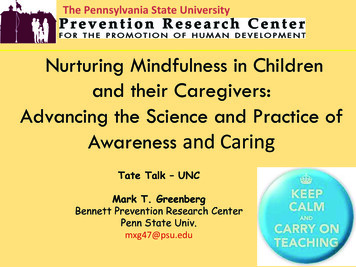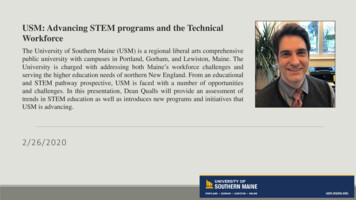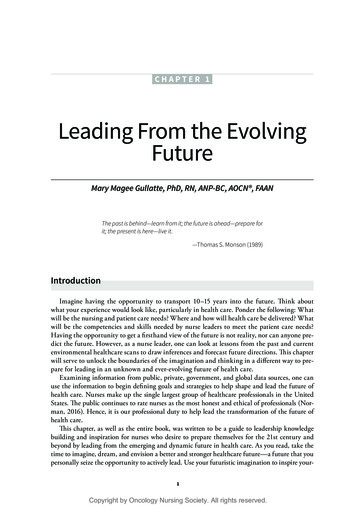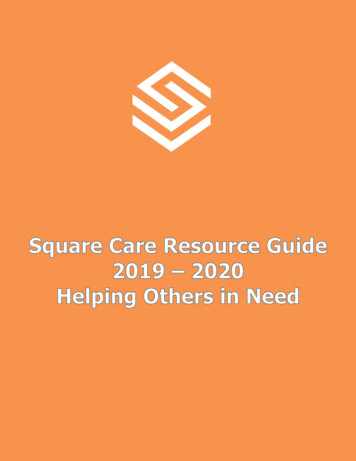
Transcription
Nurturing Mindfulness in Childrenand their Caregivers:Advancing the Science and Practice ofAwareness andCaringThePennsylvaniaStateUniversityTate Talk – UNCMark T. GreenbergBennett Prevention Research CenterPenn State Univ.mxg47@psu.edu
eawiderangeofevidence- strength- ing. ServicesforSchoolStaff– ConsultaConandproblem- ‐solving– Employeeassistanceandwellness– nDeptofPublicInstrucConhJp://sspw.dpi.wi.gov/sspw sswguide
FirstAPollwithFourQuesCons!How many here believethat our feelings affecthow children behaveand learn?
edon'tshowasmuchsensiCvityandresponsivitytokids?
managingstress?
ed?
What I will discuss What is Mindfulness and How Could it Relateto Teaching Three Studies on Nurturing Mindfulness withTeachers Why the Personal Development of Teachersis so Important for Children!!
Issues in Creating a Caring Schoolv Both Children and Adults need Emotion Regulationskillsv Teachers and Adults need to create Healthy Normsand a Safe Environmentv Schools need to adopt practices that create sharedcommunities of caringv This can include high quality SEL skills, mindfulnessskills, expressing caring and gratitudev This requires Site Director Leadership
Resilience Factors that CreateWell-Being for Childrenv Self-Control/Emotion Regulationv Cognitive Abilities – Problem Solving Skillsv Building Attention and Learning Capacityv Healthy relations withpeers and adultsv Safe, Welcoming, CaringClassrooms
ramsala
DestrucCveEmoConsMind&LifeInsCtute- ‐2000
The PATHS Curriculum“Living” The Golden Rule“Treat Others the Way you Want to Be Treated” Awareness of emotions states in oneself and othersPutting feelings into wordsThe ability to calm oneself down when feeling highlyemotionally arousedPlanning ahead and considering the effects of yourbehavior on othersDeveloping greater empathy/compassion for others
CoreSELCompetencies
Three Conditions for aCaring School?EffecCveCondiConsforLearningTeacherWell- ent
Integrated Models are the Future:We should begin to test theiradditive and synergistic effectsTeacherWell- ocialandEmoConalSkillDevelopment
MindfulnessProjects Mindfulness and Teaching – CARE Mindfulness and Parenting Mindfulness Programs for Children andYouth
WhatisMindfulness? Mindfulnessis:payinga ,non- ‐judgmentally.- ‐- ‐Kabat- ‐Zinn,1990 elaConships .areintrinsicelementsoftheculCvaConofmindfulness. racCce.Kabat- ‐Zinn201119
xts? Listeningwithfulla9en:ontochildrenandcolleagues Present- tudentsduringinteracCons Opennessandnon- ��sthoughtsandfeelings Self- ‐regula:oninteaching/paren:ng- echildandadolescentbehavior eeds–“teachablemoments” ings,Turksma,Greenberg20
onMindfulness andTeaching – CARE &CALMMindfulness andParentingMindfulness Programsfor Children and Youth
BuildingNurturingEnvironments ildrenandwehaveusedalimitedsetofpracCces essenCal.
!"# !"# !"# %&'()&#*GARRISON TurksmaandRichardBrown
munityContextFactorsJennings&Greenberg,2009
TheBurnoutCascadeEmoConalExhausConDe- nfirst5yearsofteaching(NEA,2006)
!"# !"# %&'()&#*!"# CAREProgramModel!"# %&' %()* ,'-.(.//*'(0*1./%#%.(2.*%(*30"2' %4( 5Sessions–CARE2daysCARE– 1day(2- ‐3weekslater)– 1day(2- ‐3weekslater)– 1dayboosterFOR TEACHERS PhonecoachingCultivating Awarenessand Resilience in Education
!"# !"# %&'()&#*!"# ElementsProgram!"# %&' %()* ,'-.(.//*'(0*1./%#%.(2.*%(*30"2' %4( EmoConawareness DidacCclessonsonnatureofemoCon EmoConsinrelaContoteaching&learning ExperienCalexercisestopromoteemoConalawareness MindfulnessPracCce MindfulawarenesspracCcesCARE CAREMindfulwalkingFOR TEACHERSCultivating Awarenessand Resilience in Education Empathy&Compassionforselfandother CaringpracCce(me?a) Mindfullisteningexercises leplays
CAREGoal2Outcomes assignedtoCAREorwaitlist– Pre- ‐postself- ‐report,ANCOVA– FocusgroupspostCARE
Well- e(Gross&John,2003)CovarianceAdjustedMeansd .80,p .0026d - ‐.43,p nowberg,Coccia&Greenberg,2013)
Well- s(Larsen&KasimaCs,1997)CovarianceAdjustedMeansd - ‐.32,p Coccia&Greenberg,2013)
Well- ary,Thayer,&Colvin,1991)CovarianceAdjustedMeansd - ‐.42,p nnings,Frank,Snowberg,Coccia&Greenberg,2013)
yQuesConnaire(Tschannen- d .59,p .0017.6d .56,p .0027.4d - ‐.60,p Snowberg,Coccia&Greenberg,2013)
al.,2006)CovarianceAdjustedMeansd - ‐.69,p .0034d - ‐.73,p .0063.532.5CAREControl21.510.50ObserveNon- 2013)
,whereI’mgoing rmeinlife.”
Self- aythroughmyexample.”
CARENYCClusterRCT LargerStudy tudents OneYearFollow- ‐up EffectsonTeachersandStudents
Sample 2Cohortsof36elementaryschools(2012- ‐13:8schools,2013- ‐14:28schools) c24%AfricanAmerican 5036students*– 52%female– 67%Hispanic– rd.
ha .84)TeacherEfficacyScale- ‐StudentEngagement- ‐InstrucConalEfficacy- .05POST7.006.956.906.85TXCTMean
MindfulnessAggregate( .01)MindfulnessAggregate(36items,alpha .73Five- ‐FacetMindfulnessQuesConnaire(Baer,2004):- ‐Observe- ‐Describe- ‐Awareness- ‐Non- review )3.703.653.60PRE3.55POST3.503.453.40TXCT
DistressAggregate( .05)DistressAggregate(32items,alpha .302.252.20TXCT
ClassroomobservaCon(CLASS) port
CLASSEmoConalSupport( .05)5.055.004.954.90PREPOST4.854.804.754.70TXCT
CLASSClassroomOrganizaCon( 54.70TXCT
EPOST2.552.502.452.402.35TXCT
fulness)DailyStressReduc:onProgram Developed At Penn State Primary Developer: Alexis Harris Collaborating Teacher: Karla Hudecek Collaborative Research Team:– Patricia Jennings– Rachel Abenavoli– Deirdre Katz
TheCALMProgram Based in gentle yoga and mindfulness practices y:– providingadailystressreducConpracCce– y– distress– buildasenseofcommunitywell- ‐beingacrosstheschoolProgram details: 64 scripted intervention sessions 16 weeks 20 minutes per session offered 4 days per week before school Participants were encouraged to attend two sessions per week
CALMProgramSessionFormatWelcome( 1 Minute)Centering and IntentionSetting (2 minutes)Breath AwarenessPractice (1-2 minutes)Movement Practice(8-10 minutes)Revisiting theBreath (1-2 minutes)Final Relaxation & MindfulnessPractice (3-4 minutes)Closing & Intention Setting( 1 minute) PhysicalCentering AJenContopresentmoment 3- ‐breathspracCce IntenConforpracCce
CALMProgramSessionFormatWelcome( 1 Minute)Centering and IntentionSetting (2 minutes)Breath AwarenessPractice (1-2 minutes)Movement Practice(8-10 minutes)Revisiting theBreath (1-2 minutes)Final Relaxation & MindfulnessPractice (3-4 minutes)Closing & Intention Setting( 1 minute)Examples: Breathawareness DiaphragmaCcBreathing EqualBreath LengthenedExhalaCon Victory(Ujjayi)Breath AlternateNostrilBreathing MentalAlternatenostrilBreathing
CALMProgramSessionFormatWelcome( 1 Minute)Centering and IntentionSetting (2 minutes)Breath AwarenessPractice (1-2 minutes)Movement Practice(8-10 minutes)Revisiting theBreath (1-2 minutes)Final Relaxation & MindfulnessPractice (3-4 minutes)Closing & Intention Setting( 1 minute)Examples: Seatedwarm- ‐up Mountain HalfSunSalutaCon Standingpostures(Warriorposes,Balanceposes) Seatedforwardfold Seatedtwist CorpsePose
CALMProgramSessionFormatWelcome( 1 Minute)Centering and IntentionSetting (2 minutes)Breath AwarenessPractice (1-2 minutes)Movement Practice(8-10 minutes)Revisiting theBreath (1-2 minutes)Final Relaxation & MindfulnessPractice (3-4 minutes)Closing & Intention Setting( 1 minute)Examples: RelaxaCon Self- ‐care Compassion&Lovingkindness GraCtude
LogicModelThe CALM logic model is informed by the Prosocial ClassroomModel (Jennings & Greenberg, 2009), & hypothesizes that the interventionactivities will impact educators’ social-emotional functioning, includingpsychological and physiological indicators related to stress & wellbeing, as wellas their job-related functioning. Daily Sessions: Sustained attentionon presentexperience Breathingexercises Gentle stretchingmovements Mindfulnesspractices Personal practiceoutside of classCALMInterventionActivitiesProximalProcesses Mindful awareness ofbody and mind–thoughts, emotions,behaviors, sensations Self-regulation skills Physical relaxation Positive emotionalexperience (e.g.compassion andgratitude) Sense of communitywith colleagues Improved stressmanagement,protection from theharmful effects ofstress and burnout Wellbeing –Physical andPsychological Social support Improved workrelated functioning Improved schoolrelational climateOutcomes
CALMStudyDesign PersonnelfromtwomiddleschoolsinPA RandomizedtointervenConorwait- ‐listcontrol ParCcipants:– 64educators(42teachers,22para- ywhite– 56womenand8men– meanage 43– averageof14yearsteachingexperience.
Work- ‐relatedfuncConingOutcomeβ Pretestβ ConditionEducator Self EfficacyTSES Student Engagement.54**.04TSES Classroom Management.66**.18 ES .18TSES Instructional Practices.63**.09MBI Emotional Exhaustion.80**-.07MBI Personal Accomplishment.88**.07MBI Depersonalization.70**-.17 ES .20Educator BurnoutNote: All estimates are from OLS regression models including intercept, pretest score,& condition as predictors. p .10, *p .05, **p .01
5Intervention7.47.37.27.1PrePost
ervention3.73.63.53.4PrePost
Wellbeing- ‐StressOutcomeβ Pretestβ ConditionTime UrgencyTUS Task-related hurry.70**-.17 ES .41TUS General Hurry.70**-.05Perceived StressPerceived StressNote p .10, *p .05, **p .01.77**-.11 ES .18
easeinDiastolicBloodPressure
DailyPhysicalSymptoms14% Endorsed12108Control6Intervention420PrePost
CsolAwakeningResponseCorCsolAwakeningResponse
Conclusions :– Mindfulnessandsocial- ‐emoConalcompetence– Stress- ‐management– Healthandwellbeing Thebriefdailyyoga- ‐basedformat:– Isfeasibleintheschoolse{ng– Isacceptabletoeducators– tcomesseeninotherCIformats
TentaCveConclusions aring eit strucCon ls.
enefitsofmindfulness- k,butagreaterrangeofpopulaConsthatareat- smindfulness- ‐and- ‐social- tanceinSocialWorkM.Boone
ndplaces- adaroundus,isitselfamarvelousvictory.HowardZinn
fEducaConNaConalInsCtuteofDrugAbuse
Setting (2 minutes) Breath Awareness Practice (1-2 minutes) Movement Practice (8-10 minutes) Revisiting the Breath (1-2 minutes) Final Relaxation & Mindfulness Practice (3-4 minutes) Closing & Intention Setting ( 1 minute) Examples: Seatedwarmup Mountain HalfSun










